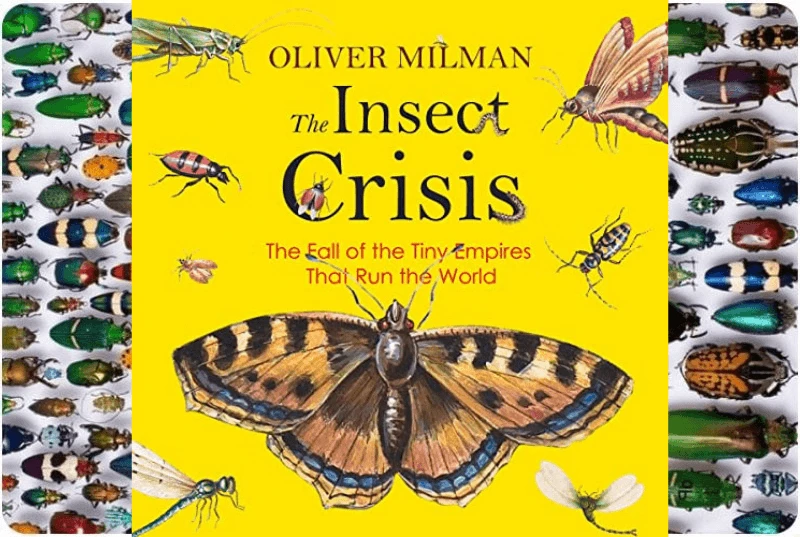‘The Insect Crisis’ book review: From climate change to habitat loss to chemicals, what’s behind the die off of insect populations?
‘The Insect Crisis’ book review: From climate change to habitat loss to chemicals, what’s behind the die off of insect populations?


When was the last time you had to clean bug splatter from your windshield? This ritual was once an inevitable coda to any long drive. Now, we’re far more likely to watch those same landscapes pass by through unblemished glass, mile after empty mile.
Blame for the crisis falls on broad biodiversity threats like habitat loss and climate change, as well as insect-specific challenges from light pollution and the rampant use of pesticides.
But [author of “The Insect Crisis” Oliver] Milman draws particular attention to the way industrial agriculture has transformed once-varied rural landscapes into vast monocultures.
Devoid of hedgerows or even many weeds, modern single-crop farms simply lack the diverse plant life necessary to support an insect community.
…
Unchecked insect declines threaten massive crop failures, collapsing food webs, bird extinctions and more.
But as the ecologist Roel van Klink observes, “Insect populations are like logs of wood that are pushed underwater.”
Remove the pressure and they bob back up again, something Milman glimpses at the Knepp estate in Sussex, where restored, pesticide-free pastures and woodlands hum with so much life they’ve become a tourist attraction. “If you squint a little,” Milman writes, “addressing the insect crisis can be viewed as surprisingly straightforward.”
This is an excerpt. Read the original post here.

 | Videos | More... |

Video: Nuclear energy will destroy us? Global warming is an existential threat? Chemicals are massacring bees? Donate to the Green Industrial Complex!
 | Bees & Pollinators | More... |

GLP podcast: Science journalism is a mess. Here’s how to fix it

Mosquito massacre: Can we safely tackle malaria with a CRISPR gene drive?

Are we facing an ‘Insect Apocalypse’ caused by ‘intensive, industrial’ farming and agricultural chemicals? The media say yes; Science says ‘no’
 | Infographics | More... |

Infographic: Global regulatory and health research agencies on whether glyphosate causes cancer
 | GMO FAQs | More... |

Why is there controversy over GMO foods but not GMO drugs?

How are GMOs labeled around the world?

How does genetic engineering differ from conventional breeding?
 | GLP Profiles | More... |

Alex Jones: Right-wing conspiracy theorist stokes fear of GMOs, pesticides to sell ‘health supplements’




 Viewpoint — Fact checking MAHA mythmakers: How wellness influencers and RFK, Jr. undermine American science and health
Viewpoint — Fact checking MAHA mythmakers: How wellness influencers and RFK, Jr. undermine American science and health Viewpoint: Video — Big Solar is gobbling up productive agricultural land and hurting farmers yet providing little energy or sustainabilty gains
Viewpoint: Video — Big Solar is gobbling up productive agricultural land and hurting farmers yet providing little energy or sustainabilty gains Fighting deforestation with CO2: Biotechnology breakthrough creates sustainable palm oil alternative for cosmetics
Fighting deforestation with CO2: Biotechnology breakthrough creates sustainable palm oil alternative for cosmetics Trust issues: What happens when therapists use ChatGPT?
Trust issues: What happens when therapists use ChatGPT? California, Washington, Oregon forge immunization alliance to safeguard vaccine access against federal undermining
California, Washington, Oregon forge immunization alliance to safeguard vaccine access against federal undermining 30-year-old tomato line shows genetic resistance to devastating virus
30-year-old tomato line shows genetic resistance to devastating virus The free-range chicken dilemma: Better for birds, but with substantial costs
The free-range chicken dilemma: Better for birds, but with substantial costs ‘You have to treat the brain first’: Rethinking chronic pain with Sanjay Gupta
‘You have to treat the brain first’: Rethinking chronic pain with Sanjay Gupta
